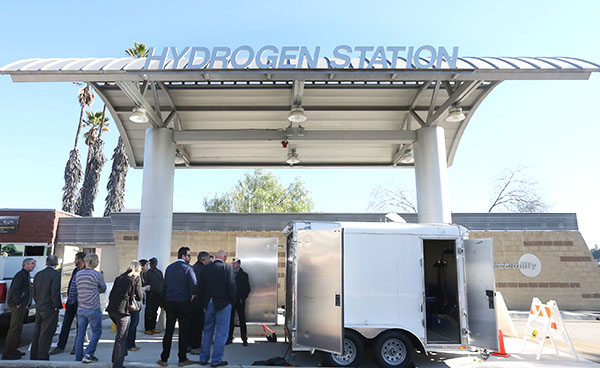Sandia brings home regional tech transfer awards
Sandia won three regional 2016 awards from the Federal Laboratory Consortium (FLC) for its work to develop and commercialize innovative technologies.
The FLC’s Mid-Continent/Far West regions recognized Sandia’s:
- GazeAppraise: Eye Movement Analysis Software won a Notable Technology Development Award.
- HyStEP: Hydrogen Station Equipment Performance Device won an Outstanding Partnership Award.
- SEARCH: The Selection, Evaluation, and Rating of Compact Heat Exchangers Software Suite won an Excellence in Technology Transfer Award.
The awards were presented Sept. 14 at the FLC Mid-Continent/Far West regional meeting in Albuquerque.
“We want our technologies commercialized for the public good,” says Jackie Kerby Moore, manager of Technology and Economic Development Dept. 1933 and Sandia’s representative to the FLC. “The FLC awards show that Sandia’s work is getting out there and making a difference.”

A Hydrogen Station Equipment Performance, or HyStEP, device, at right, prepares for testing at a California State University, Los Angeles, hydrogen station. (Photo by Dennis Schroeder/National Renewable Energy Laboratory)
Where the eye is looking
Eye tracking has been used in labs for years to measure where the eye is looking on a computer screen. The images are generally static and not being manipulated as in the workplace. When people interact with dynamic data, it is harder to measure eye movements in relation to visual stimuli, then analyze the data to develop models of perceptual and cognitive activity.
The visual cognition research community has lacked software that models how eyes dynamically recalibrate their trajectory when tracking a moving target across a scene. Sandia’s GazeAppraise software characterizes those smooth-pursuit eye movements, creating a new way to evaluate search strategies and human performance.
GazeAppraise will be added to next-generation hardware and software systems used to improve performance in dynamic image analysis applied to medical diagnostics, airport security, nuclear nonproliferation, and other areas where people work with soft-copy images.
A Cooperative Research and Development Agreement (CRADA) with EyeTracking Inc. of Solano Beach, California, has given Sandia access to an array of eye-tracking systems and a path to commercial applications.
“We know a lot about information processing, the physiology and neuroscience of visual processing,” says Laura McNamara (5346), an applied anthropologist at Sandia. “How do we take that and apply it in these highly dynamic and real-world environments?”
Speeding up the hydrogen highway
Drivers are seeing more hydrogen fuel cell electric vehicles (FCEVs) on the road, but hydrogen refueling stations are still modest in number, limiting the adoption of this zero-emission technology. The Hydrogen Station Equipment
Performance (HyStEP) device is designed to validate the safety and refueling protocols of hydrogen refueling stations and will greatly accelerate commissioning of hydrogen refueling stations in California.
Developed by Sandia and the National Renewable Energy Laboratory (NREL), HyStEP reduces the time to commission new stations from as much as months to just one week. HyStEP is funded by the Department of Energy’s Office of Energy Efficiency and Renewable Energy’s Fuel Cell Technologies Office as part of the Hydrogen Fueling Infrastructure Research and Station Technology (H2FIRST) project.
“Industry stakeholders identified station commissioning as a challenge that the national laboratories have the resources to address,” says Joe Pratt, the Sandia H2FIRST project lead. Sandia contracted with Powertech Labs to build the HyStEP device, which was then tested at NREL and is being used by the California Air Resources Board.
FCEVs create no emissions, refuel in less than five minutes and provide a range — upward of 300 miles — on par with gasoline vehicles. Hydrogen FCEVs are on the verge of revolutionizing clean-energy personal transportation. California is the state with the most FCEVs on the road and expects to have 35 operational retail hydrogen stations by the end of 2016. This momentum in clean-energy transportation is fueled by the collaboration between Sandia and NREL on the H2FIRST project, and Sandia’s research expertise in safety, codes and standards for hydrogen technologies.
Heat-transfer efficiency
The micro-channel heat exchanger (MCHE) is an emerging technology that makes power generation, refrigeration, heating, and drilling more efficient. In power generation, even small increases in heat transfer efficiency can greatly boost production and cut the cost of electricity.
Demand for industrial MCHEs has outstripped supply. Until recently, just one company — based outside the US — has done large-scale production of industrial MCHEs. A domestic supplier could reduce costs and increase supply and energy efficiency in a variety of uses.
Sandia’s SEARCH is a software suite used to design efficient MCHEs. The design has typically required a combination of analytical performance estimation, computational fluid dynamics, and finite element modeling, with each cycle taking from hours to days. Sandia’s simplified design tool uses a sub-heat exchanger thermodynamic model, American Society of Mechanical Engineers (ASME) Boiler and Pressure Vessel Code mechanical constraints, and a thermal-hydraulic solver within the Engineering Equation Solver platform to model any combination of liquid, gas, two-phase, and supercritical fluid.
The Labs partnered with US manufacturer Vacuum Process Engineering (VPE) through a CRADA to commercialize the technology. Sandia licensed SEARCH to the Sacramento, California, company, which has used it to achieve international quality standards, including ASME Boiler and Pressure Vessel Code certification, and enter the MCHE market as a domestic original equipment manufacturer. VPE produces MCHEs in the US and sells them domestically and internationally.
The FLC is a nationwide network of more than 300 members that provides the forum to develop strategies and opportunities for linking laboratory mission technologies and expertise with the marketplace.
The FLC Awards Program annually recognizes federal laboratories and their industry partners for outstanding technology transfer efforts. Since its establishment in 1984 the FLC has presented awards to nearly 200 federal laboratories, becoming one of the most prestigious honors in technology transfer.
“GazeAppraise, HyStEP, and SEARCH are great examples of how Sandia’s scientific research translates into products that benefit the public,” says Mary Monson, senior manager of Industry Partnerships Dept. 1930. “We look forward to working with partners to make these innovations widely available.”